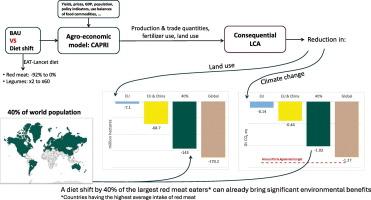将饮食转变对农业经济的影响纳入环境评估:对世界上最大的红肉食者的影响
IF 9.6
1区 环境科学与生态学
Q1 ENVIRONMENTAL STUDIES
引用次数: 0
摘要
将饮食转向更多的植物性产品被视为减轻环境足迹的最有效方法之一。然而,在环境评估中很少考虑到全球需求和供应之间的相关市场调整,并可能抵消预期的环境效益。在此背景下,我们使用了一个农业经济模型来预测2030年红肉和豆类摄入需求向《EAT-Lancet》指南转变后的全球生产变化。我们模拟了适用于不同地区的四种情景,即欧盟(EU)、欧盟和中国、40%的最大红肉食用者和整个世界。使用相应的生命周期评估对这些后续变化的环境影响进行了量化。结果表明,当最大的红肉食用人群中40%改变其饮食习惯时,就可以实现显著的环境效益。对于温室气体排放,在40%和全球饮食转变情景下,分别可减少1.02亿吨二氧化碳当量和1.27亿吨二氧化碳当量。后者相当于《巴黎协定》在2050年实现净零排放所需的年节余。大多数地方环境效益都与农业生产的区域专业化有关。例如,由于牲畜产量的减少,亚洲的酸化程度会降低;由于饲料产量的减少,美洲的水生富营养化和生态毒性会降低。为了实现这种饮食转变和相关的环境效益,应根据具体情况确定解决方案,考虑文化以及全球和区域的物理限制。本文章由计算机程序翻译,如有差异,请以英文原文为准。

Including the agro-economic effects of diet shifts into environmental assessments: Implications for the world's largest red meat eaters
Shifting one's diet towards more plant-based products is seen as one of the most efficient ways to mitigate one's environmental footprint. Yet, associated market adjustments between global demand and supply are rarely considered in environmental assessments and could counterbalance expected environmental benefits. In this context, we used an agro-economic model to predict global production changes following a demand shift towards EAT-Lancet guidelines for red meat and legume intake for the year 2030. We modelled four scenarios which apply to diverse regions, namely, the European Union (EU), EU and China, 40 % of the largest red meat eaters and the whole world. The environmental impact of these subsequent changes was quantified using consequential Life Cycle Assessment. Results show that significant environmental benefits could be achieved already when 40 % of the largest red meat-eating population shifts its diet. For greenhouse gas emissions, it translates into 1.02 GtCO2 eq and 1.27 GtCO2 eq saved in the 40 % and global diet shift scenarios, respectively. This latter is equivalent to the annual savings needed to reach net zero in 2050 for the Paris Agreement. Most of the local environmental benefits are linked to the regional specialisation of agricultural production. For example, there would be lower acidification in Asia due to the decrease in livestock production and lower aquatic eutrophication and ecotoxicity in the Americas due to the decrease in feed production. To reach such diet shifts and associated environmental benefits, context-specific solutions should be defined considering cultural and, global and regional physical constraints.
求助全文
通过发布文献求助,成功后即可免费获取论文全文。
去求助
来源期刊

Sustainable Production and Consumption
Environmental Science-Environmental Engineering
CiteScore
17.40
自引率
7.40%
发文量
389
审稿时长
13 days
期刊介绍:
Sustainable production and consumption refers to the production and utilization of goods and services in a way that benefits society, is economically viable, and has minimal environmental impact throughout its entire lifespan. Our journal is dedicated to publishing top-notch interdisciplinary research and practical studies in this emerging field. We take a distinctive approach by examining the interplay between technology, consumption patterns, and policy to identify sustainable solutions for both production and consumption systems.
 求助内容:
求助内容: 应助结果提醒方式:
应助结果提醒方式:


